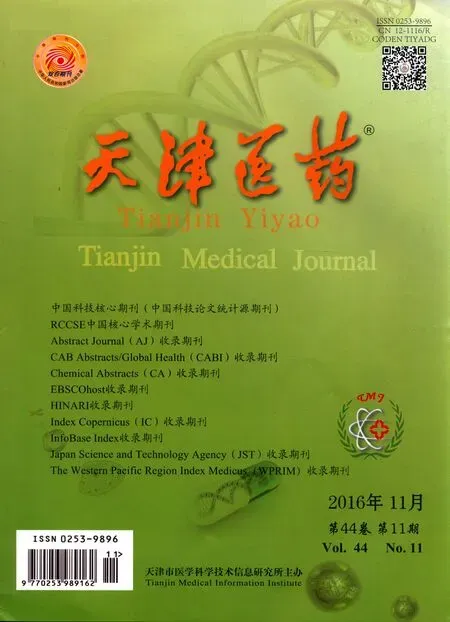高危型人乳頭瘤病毒持續感染宮頸局部免疫狀態的研究
張玲,宋華林,曲芃芃
高危型人乳頭瘤病毒持續感染宮頸局部免疫狀態的研究
張玲1,2,宋華林1,曲芃芃2△
目的探討高危型人乳頭瘤病毒(HR-HPV)持續感染過程中宮頸局部Th1、Th2、Th17相關細胞因子的變化及其與宮頸病變程度之間的關系。方法選取2015年11月—2016年1月我院陰道鏡門診有HR-HPV感染史的已婚婦女70例,按照感染情況及病理結果分為4組:轉陰組(16例),無宮頸病變組(NSIL組,18例),低級別上皮內病變組(LSIL組,18例),高級別上皮內病變組(HSIL組,18例)。其中NSIL組、LSIL組、HSIL組合并稱為持續感染組,LSIL組、HSIL組合并稱為病變組。用流式BD-CBA法檢測各組陰道灌洗液中白細胞介素(IL)-2、IL-4、IL-6、IL-10、腫瘤壞死因子(TNF)、γ干擾素(IFN-γ)及IL-17A的水平。根據病變程度、是否存在持續感染、持續感染狀態下有無病變情況比較各組細胞因子的變化,同時分析Th2/Th1、Th2/Th17變化。結果隨著病變程度的加重,IL-6的水平逐漸升高(P<0.05),LSIL組、HSIL組IL-2水平低于轉陰組和NSIL組(P<0.05),其他細胞因子水平差異無統計學意義(P>0.05)。持續感染組與轉陰組比較,病變組與NSIL組比較,均發現IL-6升高,IL-2降低。病變程度越嚴重,Th2/Th1、Th2/Th17越高。結論宮頸HR-HPV持續感染及宮頸上皮內病變的發生與宮頸局部免疫微環境密切相關。
人乳頭瘤病毒;宮頸腫瘤;宮頸上皮內瘤樣病變;Th1細胞;Th2細胞;細胞因子類;免疫微環境
子宮頸癌是婦女常見惡性腫瘤之一,其發病率在女性惡性腫瘤中居第3位,全球每年有新發病例53萬、死亡病例27.5萬[1]。流行病學證據顯示,人乳頭狀瘤病毒(HPV),尤其是高危型HPV(HRHPV)感染與子宮頸癌和宮頸上皮內病變的發生密切相關[2]。有研究提出HR-HPV持續感染才會導致宮頸癌發生[3];另有研究指出,宮頸癌是由HPV感染后引發的機體與病毒之間免疫反應的共同結果,在宮頸病變發展過程中存在由Th1/Th2平衡向Th2方向漂移的現象[4]。HPV通過微創傷感染陰道局部,全身免疫反應輕微,因此陰道局部環境的免疫狀態能更好地反映HPV感染后免疫反應的作用機制。本研究擬通過檢測陰道灌洗液中輔助性T細胞(Th細胞)相關細胞因子水平,探討HR-HPV感染與Th細胞分化之間的關系并分析Th細胞分化對宮頸病變進展的影響。
1 對象與方法
1.1 研究對象選取2015年11月—2016年1月就診于天津市中心婦產科醫院陰道鏡門診的有HR-HPV感染史的70例患者。按照HR-HPV感染狀態及宮頸活檢病理結果分為4組:(1)既往有HR-HPV感染,目前轉陰(轉陰組,16例)。(2)HR-HPV持續感染但無宮頸病變(NSIL組,18例)。(3)HR-HPV持續感染并有低級別上皮內病變(LSIL組,18例)(4)HR-HPV持續感染并有高級別上皮內病變(HSIL組,18例)。其中(2)、(3)、(4)組合并為持續感染組,(3)、(4)組合并為病變組。以感染持續時間>半年,且HR-HPV陽性≥2次定義為持續感染。各組間年齡及孕產次差異均無統計學意義(均P>0.05),見表1。入選標準:年齡20~65歲;有性生活史;無急性生殖道炎癥;非月經期;3 d內無性行為及陰道用藥。排除標準:患有自身免疫性疾病、非宮頸組織惡性腫瘤、嚴重內科疾病及肝腎功能異常者;妊娠或因其他原因行子宮次全切除術者;6個月內曾使用糖皮質激素、免疫抑制或免疫調節藥物者。標本采集均經過研究對象同意并簽署知情同意書。
Tab.1Comparison of the baseline information between different groups表1 各組基線資料比較

Tab.1Comparison of the baseline information between different groups表1 各組基線資料比較
均P>0.05
組別轉陰組NSIL組LSIL組HSIL組F n 16 18 18 18年齡(歲)43.06±10.02 42.11±10.19 41.33±11.36 43.22±6.72 0.145孕(次)3.06±1.65 2.44±1.34 2.22±1.44 2.33±1.33 1.129產(次)1.06±0.57 1.22±0.81 1.06±0.73 1.17±0.51 0.261
1.2 方法
1.2.1 樣本收集取5 mL滅菌生理鹽水沖洗宮頸及陰道上1/3,停留10 s后于后穹窿處收集灌洗液4~5 mL(所有灌洗液中均不含血液成分),2 000 r/min室溫離心5 min,留取上清液保存于-70℃備檢。
1.2.2 標本檢測采用流式CBA人Th1/Th2/Th17試劑盒(美國BD公司,貨號560484)檢測灌洗液中白細胞介素(IL)-2、IL-4、IL-6、IL-10、腫瘤壞死因子(TNF)、γ干擾素(IFN-γ)、IL-17A水平。操作步驟按說明書進行:充分混勻人Th1/Th2/Th17細胞因子捕獲微球A1~A7,取2 mL實驗稀釋液溶解標準品小球,梯度稀釋制備人Th1/Th2/Th17細胞因子標準品。每個管中加入50 μL混勻的捕獲微球,標準品管中分別加入50 μL梯度稀釋的標準品,實驗管中加入50 μL待測樣本,設置好參數后上機檢測。
1.3 統計學方法數據采用SPSS 17.0軟件進行統計學分析。計量資料采用均數±標準差表示,多組間均數比較采用方差分析,組間多重比較采用LSD-t法;2組間均數比較采用獨立樣本t檢驗,以雙側P<0.05為差異具有統計學意義。
2 結果
2.1 各組7種細胞因子水平比較(1)~(3)組IL-2水平逐漸降低(P<0.05),(3)組與(4)組IL-2水平差異無統計學意義;(1)~(4)組IL-6水平逐漸升高,差異有統計學意義(P<0.05);其他細胞因子各組間差異無統計學意義,見圖1、表2。是否持續感染比較:持續感染組較轉陰組IL-2水平降低,IL-6水平升高(P<0.05),見表3。是否病變比較:病變組較NSIL組IL-2水平降低,IL-6水平升高(P<0.01),見表4。

Fig.1The levels of cytokines in different groups detected by BD CBA圖1 BD CBA檢測各組細胞因子水平
2.2Th1、Th2、Th17細胞的關系隨著病變程度的加重,(1)~(4)組IL-6/IL-2、IL-6/IL-17A均逐漸升高,組間多重比較差異有統計學意義(均P<0.05),見表5。
Tab.2Comparison of the levels of seven cytokines between different groups表2 不同組間7種細胞因子水平比較(ng/L,)

Tab.2Comparison of the levels of seven cytokines between different groups表2 不同組間7種細胞因子水平比較(ng/L,)
**P<0.01;a與轉陰組比較,b與NSIL組比較,c與LSIL組比較,P<0.05
組別轉陰組(1)NSIL組(2)LSIL組(3)HSIL組(4)F n 16 18 18 18 IL-2 7.70±0.62 7.26±0.44a 6.83±0.61ab 6.78±0.59ab 9.664**IL-4 4.46±0.57 4.32±0.53 4.43±0.52 4.50±0.61 0.354 IL-6 7.48±3.93 8.34±7.39a 21.84±13.61ab 43.55±20.07abc 11.635**IL-10 3.17±0.33 3.24±0.34 3.45±0.99 3.40±0.65 0.732 TNF 3.61±0.66 3.53±0.57 3.99±2.40 3.99±1.98 0.396 IFN-γ 3.13±0.41 2.96±0.32 2.95±0.45 3.03±0.37 0.791 IL-17A 11.16±3.04 10.95±1.82 11.95±4.51 12.08±1.83 0.626
Tab.3Comparison of the levels of seven cytokines between the negative group and persistent infection group表3 轉陰組與持續感染組7種細胞因子水平比較(ng/L,)

Tab.3Comparison of the levels of seven cytokines between the negative group and persistent infection group表3 轉陰組與持續感染組7種細胞因子水平比較(ng/L,)
*P<0.05,**P<0.01
組別轉陰組持續感染組t n 16 54 IL-2 7.70±0.62 6.96±0.58 4.436**IL-4 4.46±0.57 4.42±0.55 0.132 IL-6 7.48±3.93 20.95±19.80 2.429*IL-10 3.17±0.33 3.37±0.70 1.094 TNF 3.61±0.66 3.84±1.80 0.503 IFN-γ 3.13±0.41 3.00±0.36 1.413 IL-17A 11.16±3.04 11.66±2.99 0.585
Tab.4Comparison of the levels of seven cytokines between the lession group and non-lession group表4 有無病變組7種細胞因子水平比較(ng/L,)

Tab.4Comparison of the levels of seven cytokines between the lession group and non-lession group表4 有無病變組7種細胞因子水平比較(ng/L,)
**P<0.01
組別NSIL組病變組t n 18 36 IL-2 7.26±0.44 6.80±0.59 2.865**IL-4 4.32±0.53 4.47±0.56 0.935 IL-6 8.34±7.39 27.26±21.07 3.682**IL-10 3.24±0.34 3.43±0.82 0.900 TNF 3.53±0.57 3.99±2.17 0.876 IFN-γ 2.96±0.32 2.99±0.37 0.314 IL-17A 10.95±1.82 12.02±3.40 1.249

Tab.5Comparison of the ratio of Th1/Th2/Th17 between different groups表5 不同組間Th1/Th2/Th17細胞比值關系比較
3 討論
從HR-HPV感染到發生宮頸癌變大約需要10年的時間[5]。HPV侵入機體后,在引起感染的同時也會觸發一系列的免疫反應,宮頸癌的發生是HPV與免疫反應共同作用的結果[4]。本研究通過檢測陰道灌洗液中細胞因子水平來觀察HR-HPV持續感染過程中宮頸局部免疫微環境的變化。Th1相關細胞因子主要包括IL-2、IFN-γ、TNF等,主要介導細胞免疫反應,有利于抵抗胞內病原體感染[6]。Th2相關細胞因子包括IL-4、IL-6、IL-10等,會對機體的抗腫瘤免疫產生干擾[7]。正常生理情況下,Th1、Th2兩類細胞處于相互轉化、相互抑制的平衡狀態,一旦打破這種平衡,機體就會出現炎癥、腫瘤等病理反應。研究發現在HR-HPV持續感染過程中存在Th1/Th2漂移現象[4,8-10]。本研究發現,HSIL組IL-6/ IL-2值明顯高于其余3組,提示Th1向Th2漂移可能會促進宮頸病變進展。IL-2在HSIL組與LSIL組間無明顯差異,提示其可能只參與HR-HPV持續感染的早期階段,并不影響病變進展。
已有研究發現HR-HPV持續感染過程中會出現IL-10水平升高[11]。且Scott等[8]發現IL-10的水平上升會減少宮頸上皮內瘤變(CIN)2、3的發生。Baker等[12]發現TNF水平升高會促進HPV持續感染,而余楊等[9]發現隨著宮頸癌病變的持續進展,TNF水平呈下降趨勢。而本研究并未發現IL-10、TNF在各組間的變化差異,推測其原因一方面可能因為樣本量較少,另一方面宮頸局部可能與外周血中細胞因子水平并不一致。Th17與調節性T細胞(Treg)比例失調會引起自身免疫性疾病及腫瘤的發生[13]。初始CD4+T細胞在TGF-β、IL-6共同作用下分化為Th17細胞,在TGF-β單獨誘導下分化為Foxp3+Treg細胞。Th17細胞主要分泌IL-17A。童丹等[14]發現IL-6、IL-17在組織學水平與宮頸病變程度呈正相關。另有研究提示IL-17可以上調IL-6濃度,從而促進宮頸癌細胞生長[15]。本研究中NSIL~HSIL組中IL-6水平逐漸升高,與上述結果部分一致,但各組間IL-17A變化并不明顯,需加大樣本量繼續觀察。
綜上所述,在HR-HPV持續感染至引起宮頸病變的過程中,陰道局部灌洗液能更好地反映宮頸局部的抗病毒效應。本研究同時檢測多種因子,并分析各細胞因子之間的比例關系,有效地排除了取樣方法上造成的誤差。后期需要進一步擴大樣本量,篩查出與HR-HPV持續感染及病變進展過程關系密切的因子,進一步對有意義的細胞因子進行信號通路的研究,為指導HR-HPV持續感染后的處理及預防宮頸鱗狀上皮內病變的進展提供更多依據。
[1]Schiffman M,Solomon D.Clinical practice.Cervical-cancer screening with human papillomavirus and cytologic cotesting[J].N Engl J Med,2013,369(24):2324-2331.doi:10.1056/ NEJMcp1210379.
[2]Woodman CB,Collins S,Winter H,et al.Natural history of cervical human papillomavirus infection in young women:a longitudinal cohort study[J].Lancet,2001,357(9271):1831-1836.doi:10.1016/S0140-6736(00)04956-4.
[3]Rodriguez AC,Schiffman M,Herrero R,et al.Longitudinal study of human papillomavirus persistence and cervical intraepithelial neoplasia grade 2/3:critical role of duration of infection[J].J Natl Cancer Inst,2010,102(5):315-324.doi:10.1093/jnci/djq001.
[4]Hong H,Wang H,Jia CY,et al.Changes of concentration of immune inflammatory cytokines within cervical microenvironment infected with HR-HPV[J].Anhui Medical Journal,2014,35(1):9-12.[洪慧,王鶴,賈超穎,等.HR-HPV感染后宮頸微環境中免疫炎癥因子變化[J].安徽醫學,2014,35(1):9-12].doi:10.3969/j. issn.1000-0399.2014.01.003.
[5]Xie JY,Xie JN,Yu KJ,et al.The relationship between the load and duration of high-risk human papillomavirus and cervical lesion in pregnant women[J].Chinese Journal of Clinical Obstetrics and Gynecology,2015,16(6):550-552.[謝建渝,謝家寧,虞柯靜,等.孕婦高危型人乳頭瘤病毒載量和持續時間與宮頸病變的關系[J].中國婦產科臨床雜志,2015,16(6):550-552].doi:10.13390/j.issn.1672-1861.2015.06.022.
[6]Andersen AS,Koldjaer S?lling AS,Ovesen T,et al.The interplay between HPV and host immunity in head and neck squamous cell carcinoma[J].Int J Cancer,2014,134(12):2755-2763.doi:10.1002/ijc.28411.
[7]Lippitz BE.Cytokine patterns in patients with cancer:a systematic review[J].Lancet Oncol,2013,14(6):218-228.doi:10.1016/ S1470-2045(12)70582-X.
[8]Scott ME,Ma Y,Kuzmich L,et al.Diminished IFN-gamma and IL-10 and elevated Foxp3 mRNA expression in the cervix are associated with CIN 2 or 3[J].Int J Cancer,2009,124(6):1379-1383.doi:10.1002/ijc.24117.
[9]Yu Y,Zou JJ.Relationship and clinical significance between T helper cell and cervical lesions among patient with high risk of HPV infection[J].Chinese Journal of Women and Children Health,2016,7(2):51-54.[余楊,鄒晶晶.高危型人乳頭狀瘤病毒和Th細胞因子與宮頸病變的關系及意義[J].中國婦幼衛生雜志,2016,7(2):51-54].
[10]Liu K,Zhao JQ,Jiang B.Analysis of the drift of Th1/Th2 type cytokines of peripheral blood CD4+T lymphocytes in patients with cancer pain[J].Journal of Cancer Control and Treatment,2009,22(3):250-253.[劉坤,趙金奇,江波.癌痛患者外周血CD4+T淋巴細胞Th1/Th2漂移檢測與分析[J].腫瘤預防與治療,2009,22(3):250-253].doi:10.3969/j.issn.1674-0904.2009.03.005.
[11]Zhang M,Xiao FY,Li B,et al.Correlation between high-risk HPV infection and γ-interferon and interleukin-10 expression in cervical lesions[J].Journal of Hainan Medical University,2015,21(5):772-774,777.[張敏,肖鳳儀,李波,等.高危型HPV感染與宮頸病變組織IFN-γ、IL-10表達的相關性研究[J].海南醫學院學報,2015,21(5):772-774,777].doi:10.13210/j.cnki. jhmu.20150116.015.
[12]Baker R,Dauner JG,Rodriguez AC,et al.Increased plasma levels of adipokines and inflammatory markers in older women with persistent HPV infection[J].Cytokine,2011,53(3):282-285.doi:10.1016/j.cyto.2010.11.014.
[13]Tang MW.Study on the regulation of Th17/Treg cells and related cytokines[J].J Hexi Univ,2015,31(2):80-83.[湯美雯.Th17/ Treg細胞及相關細胞因子平衡調節的研究[J].河西學院學報,2015,31(2):80-83].doi:10.13874/j.cnki.62-1171/g4.2015.02. 014.
[14]Tong D,Song WJ.Expressions and clinical significances of IL-17,IL-6 and TGF-β1 in cervical intraepithelial neoplasia and cervical cancer[J].Chin Matern Child Health Care,2014,29(24):3984-3986.[童丹,宋文靜.IL-17、IL-6和TGF-β1在宮頸上皮內瘤變和宮頸癌中的表達及臨床意義[J].中國婦幼保健,2014,29(24):3984-3986]. doi:10.7620/zgfybj.j.issn.1001-4411.2014.24.45.
[15]Gosmann C,Mattarollo SR,Bridge JA,et al.IL-17 suppresses immune effector functions in human papillomavirus-associated epithelial hyperplasia[J].J Immunol,2014,193(5):2248-2257. doi:10.4049/jimmunol.1400216.
(2016-06-13收稿2016-09-10修回)
(本文編輯胡小寧)
Study on local immune status in women with cervical persistent infection of high-risk human papillomavirus
ZHANG Ling1,2,SONG Hualin1,QU Pengpeng2△
1 Tianjin Medical University,Tianjin 300070,China;2 Tianjin Central Hospital of Gynecology and Obstetrics△
ObjectiveTo explore the changes of cervical local cytokines Th1,Th2 and Th17 in the process of high risk human papillomavirus(HR-HPV)persistent infection and their relationship with cervical lesions.MethodsA total of seventy married women who were referred to colposcopy clinic in our hospital from November 2015 to January 2016 were included in this research.According to the HR-HPV infection status and pathological results,patients were divided into four groups:the cleared group(n=16),no squamous intraepithelial lesion group(NSIL,n=18),low-grade squamous intraepithelial lesion group(LSIL,n=18)and high-grade squamous intraepithelial lesion group(HSIL,n=18).The NSIL group,LSIL group and HSIL group were merged into the persistent infection group,while the LSIL group and HSIL group were amalgamated into the diseased group.The concentrations of interleukin-2(IL-2),IL-4,IL-6,IL-10,IL-17A,tumor necrosis factor(TNF) and γ-interferon(IFN-γ)in vaginal douche were measured by BD cytometric bead array.The changes of the above cytokines and the relationship between Th2/Th1 and Th2/Th17 were analyzed according to the severity,persistent status and disease status.ResultsThe levels of IL-6 increased significantly with the severity of disease(P<0.05),while the levels of IL-2 were decreased significantly in LSIL group and HSIL group compared with those of the cleared group and NSIL group (P<0.05).The other cytokines showed no significant differences between the four groups(P>0.05).Compared with the cleared group,the level of IL-6 increased and IL-2 decreased in persistent infection group,which showed a same results in the diseased group compared with NSIL group.The more serious of the diseases,the higher levels in Th2/Th1 and Th2/Th17. ConclusionThe persistence of HR-HPV infection and the occurrence of cervical intraepithelial lesion are closely related with the cervical local immune microenvironment.
human papillomavirus;uterine cervical neoplasms;cervical intraepithelial neoplasia;Th1 cells;Th2 cells; cytokines;immune microenvironment
R711.74,R737.33
A
10.11958/20160549
天津市衛生行業重點攻關項目(15KG140);天津市科技計劃項目(09ZCZDSF03900)
1天津醫科大學(郵編300070);2天津市中心婦產科醫院
張玲(1990),女,碩士研究生在讀,主要從事婦科腫瘤研究
△通訊作者E-mail:Qu.pengpeng@hotmail.com

